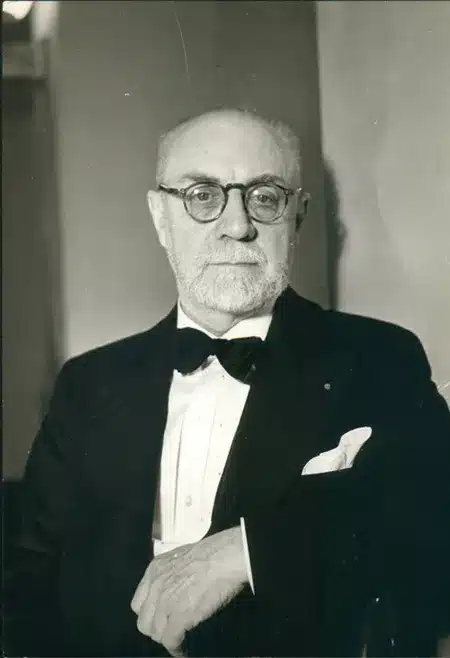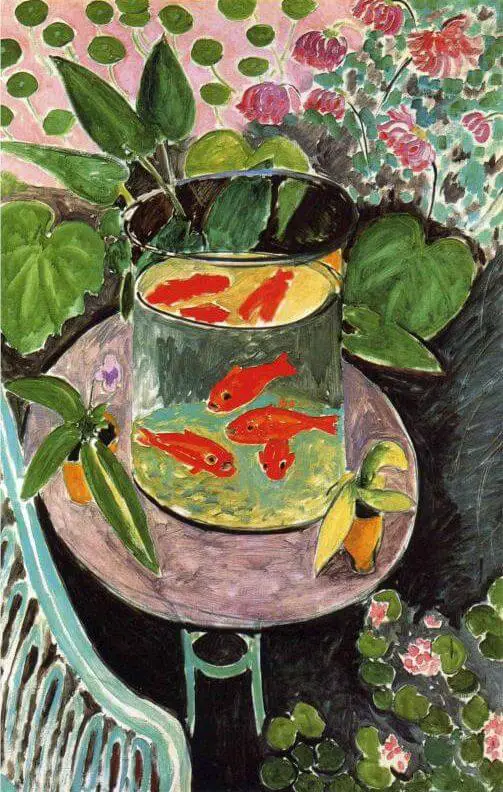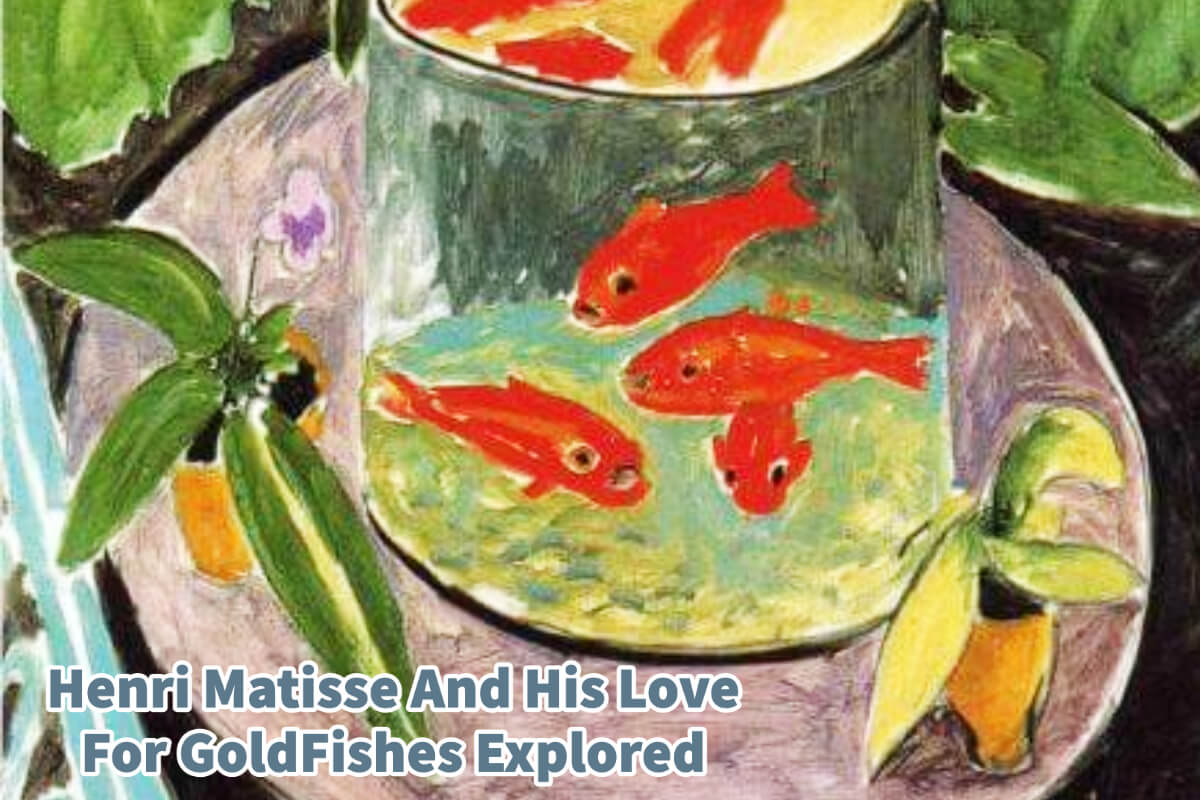Henri Matisse, renowned as a leading light in the Fauvist movement, had a profound artistic voice resonating in many art enthusiasts’ hearts. I love his work, as many paintings are bright and colorful.
His body of work is often recognized by a recurring motif that dances across his canvases—goldfish. Though these creatures frequently appear in Matisse’s paintings, not many viewers grasp the depth of symbolism that these vibrant aquatic beings carry and how their meaning contributed to Matisse’s deep-seated admiration for them.
Table of Contents
- Henri Matisse: An Exploration Of Color, Form, And The Alluring World Of Goldfish
- Frequently Asked Questions
- Related Questions
Henri Matisse: An Exploration Of Color, Form, And The Alluring World Of Goldfish
Henri Matisse, a beacon of the early 20th-century art world, was renowned for his revolutionary approach to color and form. A leading figure of the Fauvist movement—an avant-garde development that marked the beginning of modern art—Matisse’s unique style was a pivotal turning point in the Post-impressionist era.

His groundbreaking oeuvre transformed art history, leaving an indelible legacy that resonates with contemporary artists and art lovers alike.
A Bit About Henri Matisse – The Fauvist Painter
Before delving into Matisse’s fascination with goldfish, let’s explore his artistic journey, which began in France. Matisse was born in Le Cateau-Cambrésis, in northern France, in 1869.
Initially studying law, he decided to become a painter at 21 after a bout of appendicitis left him bedridden, and he turned to painting to pass the time. Matisse quickly discovered his passion for the craft and subsequently studied at the prestigious École des Beaux-Arts in Paris.
Matisse’s early work was heavily influenced by the great masters, particularly the works of Van Gogh, Cézanne, and Gauguin.
Over time, his style began to evolve. Matisse started to explore using bright, non-naturalistic colors inspired by Post-Impressionism and Pointillism. This evolution culminated in the formation of the Fauvist movement, with Matisse at the helm.
Fauvism, characterized by the use of intense color to convey emotions, broke away from the traditional norms of painting, propelling the art world into a new era of creativity.
Matisse On His Trip To Morocco And GoldFish
The turning point in Matisse’s relationship with the goldfish motif came in 1912 when he embarked on a trip to Morocco. Matisse was captivated by the Moroccan culture and landscapes, but a local custom intrigued him the most.
He observed people peacefully watching goldfish swim in bowls, a practice he noticed induced a meditative state. This sight profoundly influenced Matisse, making him adopt the goldfish as a recurring motif in his art.
Matisse And His Symbols Of The GoldFish

Matisse’s fascination with goldfish was not merely as aesthetic objects; he saw them as symbolizing a tranquil, meditative state—a world within a world. The goldfish, encased in their glass aquariums, offered a form of escapism, a refuge from the chaotic realities of the world.
Matisse once stated,
“I don’t paint things. I only paint the difference between things.”
Henri Matisse
“I don’t paint things. I only paint the difference between things.” This philosophy becomes evident when examining his goldfish paintings, as the artist beautifully contrasts the serene world of the goldfish with the dynamic world outside the bowl.
Matisse And His GoldFish Paintings
From the mid-1910s to the late 1920s, the goldfish motif frequently appeared in Matisse’s art as central figures and elements in larger compositions. His paintings from this period are vibrant symphonies of color, where the orange-red hues of the goldfish create a striking contrast against the cool blues and greens of their surroundings.

The goldfish became a central feature in Matisse’s studio depictions, subtly symbolizing the artist’s internal world. Henri Matisse said this about the goldfish:
“I wouldn’t mind turning into a vermilion goldfish.”
Henri Matisse
Art historians and critics have often interpreted Matisse’s goldfish works as exploring themes such as tranquility, contemplation, and spatial configuration. The goldfish bowl, a world within a world, mirrors the artist’s studio—an isolated sanctuary where the chaos of the world outside is kept at bay.
Matisse invited his viewers into this tranquil space through his imaginative use of color and composition, allowing them to experience the serene simplicity of watching goldfish swim, just as he had experienced in Morocco.
Matisse’s exploration of the goldfish motif extended beyond painting. He also incorporated it into his etchings, drawings, and prints, further underlining his fascination with these creatures.
Despite the simplicity of the subject matter, Matisse succeeded in creating deeply evocative and complex works, once again demonstrating his extraordinary ability to transform the ordinary into the extraordinary.
Henri Matisse’s journey with the goldfish motif is a fascinating study of the intersection of personal experience, cultural influence, and artistic vision. The seemingly simple act of watching goldfish swim around a bowl led Matisse to create some of the most visually arresting and emotionally charged works of his career.
These works, imbued with a sense of tranquility and contemplation, serve as a testament to Matisse’s genius—his ability to capture the essence of life in all its complexity within the confines of a canvas.
Anita Louise Art is dedicated to art education, great artists, and inspiring others to find and create their art. We love art that uplifts and inspires. #ArtToMakeYouSmile! #ArtToMakeYouHappy!
If you want to see any of my art, you can find out more by clicking here. If you are interested in what inspires me and my paintings, you can discover more by clicking here.
We have a free newsletter and would love you to be part of our community; you can subscribe to the newsletter by clicking here. I would be happy to talk to you if you have any questions. You can reach me, Anita, by clicking here.
Subscribe to our Anita Louise Art YouTube Channel with great videos and information by clicking here.
Join us for our podcast “5 Minutes With Art.” Spend just 5 minutes a week with us to discover and learn about great art and artists. You can find out more about our podcast by clicking here.
Frequently Asked Questions
Why did Henri Matisse incorporate goldfishes into so many of his paintings?
Matisse found inspiration in the vibrant colors and fluid movements of goldfish, considering them symbolic of life and energy. The inclusion of goldfish in his artworks added dynamic elements to his compositions.
What is the significance of goldfish in Henri Matisse’s art?
Goldfish in Matisse’s art are often seen as symbols of vitality, freedom, and the ever-changing nature of life. Their graceful movements and brilliant colors served as metaphors for the artist’s own creative expression.
How did Matisse’s fascination with goldfish influence his artistic style?
Matisse’s love for goldfish played a crucial role in shaping his use of color and form. The fluidity and brilliance of the fish inspired his bold and vibrant color palette, characteristic of the Fauvist movement.
Were goldfish a recurring theme throughout Matisse’s entire career, or did their significance change over time?
Goldfish remained a consistent motif throughout Matisse’s career, but the interpretation and symbolic meaning evolved. Early on, they represented simple beauty, while later in his career, they symbolized more complex ideas related to life and creativity.
Can you name some of Henri Matisse’s famous paintings featuring goldfish?
Some notable paintings include “Goldfish and Palette,” “Goldfish and Sculpture,” and “The Goldfish.” These artworks showcase Matisse’s mastery in capturing the essence and symbolism of goldfish.
Did Matisse ever explain the personal connection he felt with goldfish?
While Matisse did not explicitly detail a personal connection, his use of goldfish is often linked to his appreciation for the beauty in everyday life and nature. The fish became a metaphor for the artist’s perception of the world around him.
How did critics and contemporaries react to Matisse’s incorporation of goldfish in his art?
Initially, some critics were puzzled by Matisse’s bold choices, but over time, his innovative use of goldfish gained recognition and praise. Fellow artists and admirers acknowledged the unique symbolism and aesthetic appeal in his paintings.
Did Matisse have any specific rituals or routines related to his artistic process involving goldfish?
There is no documented evidence of specific rituals, but Matisse was known for his meticulous and contemplative approach to art. He likely observed goldfish closely, studying their movements and colors, to inform his creative process.
Are there any hidden meanings or messages associated with the portrayal of goldfish in Matisse’s art?
The interpretation of goldfish in Matisse’s art is subjective, but many art historians suggest that they represent the fleeting and transient nature of life, as well as the artist’s pursuit of capturing beauty and joy in his work.
Did Matisse’s love for goldfish influence other artists or movements in the art world?
Matisse’s innovative use of goldfish, along with his overall contribution to the Fauvist movement, had a profound impact on subsequent artists. His bold use of color and symbolic motifs inspired many within and beyond his contemporary art circles.
Related Questions
Why Paintings Like Rothko’s No. 6 (Violet, Green, & Red) Are Expensive
Mark Rothko’s No 6 (Violet, Green, and Red – 1951) was sold in 2014 for 140,000.000 Euro or over 184,000,000 USD. A huge amount for any painting. Many of Mark Rothko’s paintings fetch record numbers at auction houses worldwide.
You can learn more by clicking here by reading Why Paintings Like Rothko’s No. 6 (Violet, Green, & Red) Are Expensive.
What Makes Mark Rothko’s Paintings So Valuable?
Mark Rothko’s paintings have been valuable for many years; they are in high demand and continue to fetch record prices around the globe. At first glance, the paintings may look simple, but upon closer look, they are very complex; they are meant to evoke our emotions and transport us to another realm.
By clicking here, you can discover more by reading What Makes Mark Rothko’s Paintings So Valuable.
The Last Painting Created By Mark Rothko Before His Death
Mark Rothko’s final painting is a bright red painting called Untitled, 1970 which many feel symbolizes blood, particularly his blood, as he died from an overdose and slashed his wrists; Mark Rothko was 66 years old and left no suicide note. Before his death, we know that he also painted a black and grey series that many have felt was his painted suicide note.
By clicking here, you can learn more by reading The Last Painting Created By Mark Rothko Before His Death.

